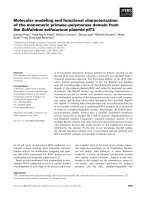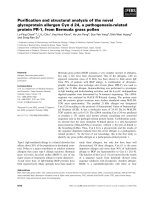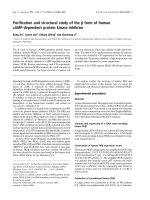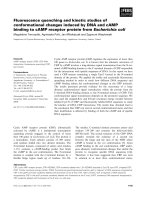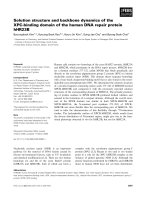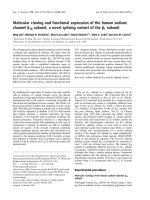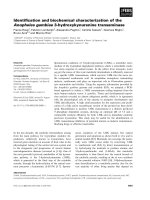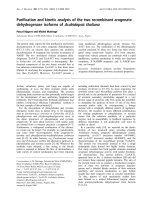Báo cáo toán học: "Antioxidant, antimicrobial, and theoretical studies of the thiosemicarbazone derivative Schiff base 2-(2-imino-1-methylimidazolidin-4-ylidene)hydrazinecarbothioamide (IMHC)" potx
Bạn đang xem bản rút gọn của tài liệu. Xem và tải ngay bản đầy đủ của tài liệu tại đây (319.33 KB, 23 trang )
This Provisional PDF corresponds to the article as it appeared upon acceptance. Fully formatted
PDF and full text (HTML) versions will be made available soon.
Antioxidant, antimicrobial, and theoretical studies of the thiosemicarbazone
derivative Schiff base
2-(2-imino-1-methylimidazolidin-4-ylidene)hydrazinecarbothioamide (IMHC)
Organic and Medicinal Chemistry Letters 2012, 2:4 doi:10.1186/2191-2858-2-4
Ahmed A Al-Amiery ()
Yasmien K Al-Majedy ()
Heba H Ibrahim ()
Ali A Al-Tamimi ()
ISSN 2191-2858
Article type Original
Submission date 14 September 2011
Acceptance date 2 February 2012
Publication date 2 February 2012
Article URL />This peer-reviewed article was published immediately upon acceptance. It can be downloaded,
printed and distributed freely for any purposes (see copyright notice below).
For information about publishing your research in Organic and Medicinal Chemistry Letters go to
/>For information about other SpringerOpen publications go to
Organic and Medicinal
Chemistry Letters
© 2012 Al-Amiery et al. ; licensee Springer.
This is an open access article distributed under the terms of the Creative Commons Attribution License ( />which permits unrestricted use, distribution, and reproduction in any medium, provided the original work is properly cited.
Antioxidant, antimicrobial, and theoretical studies of the thiosemicarbazone
derivative Schiff base 2-(2-imino-1-methylimidazolidin-4-
ylidene)hydrazinecarbothioamide (IMHC)
Ahmed A Al-Amiery*, Yasmien K Al-Majedy, Heba H Ibrahim and Ali A Al-Tamimi
Biotechnology Division, Applied Science Department, University of Technology,
Baghdad 10066, Iraq
*Corresponding author:
Email addresses:
YKA:
HHI:
AAAT:
Abstract
Background: Adverse antimicrobial activities of thiosemicarbazone (TSC) and Schiff
base derivatives have widely been studied by using different kinds of microbes, in
addition different methods were used to assay the antioxidant activities using DPPH,
peroxids, or ntrosyl methods. However, there are no studies describing the synthesis of
TSC derived from creatinine.
Results: In this study, 2-(2-imino-1-methylimidazolidin-4-
ylidene)hydrazinecarbothioamide (IMHC) was synthesized by the reaction of creatinine
with thiosemicarbazide. The novel molecule was characterized by FT-IR, UV-VIS, and
NMR spectra in addition of the elemental analysis. The free radical scavenging ability of
the IMHC was determined by it interaction with the stable-free radical 2,2″-diphenyl-1-
picrylhydrazyl (or nitric oxide or hydrogen peroxide) and showed encouraging
antioxidant activities. Density functional theory calculations of the IMHC performed
using molecular structures with optimized geometries. Molecular orbital calculations
provide a detailed description of the orbitals, including spatial characteristics, nodal
patterns, and the contributions of individual atoms. Highest occupied molecular orbital–
lowest unoccupied molecular orbital energies and structures are shown.
Conclusions: IMHC shows considerable antibacterial and antifungal activities. The free
radical scavenging activity of synthesized compound was screened for in vitro
antioxidant activity.
Keywords: antibacterial; antioxidant; antifungal; creatinine; Schiff base;
thiosemicarbazone.
Background
Schiff-base compounds have been used as fine chemicals and medical substrates [1].
Azomethine group (–C=N–)-containing compounds, typically known as Schiff’s bases,
have been synthesized via condensation of primary amines with active carbonyls. It is
well established that the biological activity of hydrazone compounds is associated with
the presence of the active (–CO–NHN=C–) pharmacophore and these compounds form a
significant category of compounds in medicinal and pharmaceutical chemistry with
several biological applications that include antitumoral [2, 3], antifungal [4–9],
antibacterial [10, 11], antimicrobial [12], and anthelmintic uses [13]. Schiff’s base
complexes play an important role in designing metal complexes related to synthetic and
natural oxygen carriers [14, 15]. Schiff bases (SBs) are important intermediates for the
synthesis of some bioactive compounds such as ß-lactams [16–18], and employed as
ligands for the complexation of metal ions [19]. SBs and their complexes are largely
studied because they interested and important properties such as their ability to bind
reversibly oxygen [20] redox systems in biological systems and oxidation of DNA [21].
Antioxidants are extensively studied for their capacity for protect organism and cell from
damage that is induced by oxidative stress. Scientists in many different disciplines
become more interested in new compounds, either synthesized or obtained from natural
sources that could provide active components to prevent or reduce the impact of
oxidative stress on cell [22, 23].
The preparation of a 2-(2-imino-1-methylimidazolidin-4-
ylidene)hydrazinecarbothioamide (IMHC) from thiosemicarbazide and creatinine is
presented in this study. The structure established based on the extensive NMR
spectroscopic studies. The microbial activities of IMHC and their in vitro antioxidant
activities were also investigated. It was envisaged that these two active pharmacological
molecules (thiosemicbazide and creatinine) if linked together would generate novel
molecular templates, which are likely to exhibit interesting biological properties.
Results and discussion
Chemistry
UV/visible spectra
The UV–VIS of IMHC was recorded. The solution of IMHC in DMF exhibited two
peaks at 255 and 322 nm (39215 and 31055 cm
–1
) which are attributed to π → π* or
n → π*.
FT-IR spectroscopy
The FT-IR spectra provide valuable information regarding the nature of functional group
of IMHC. The appearance of a broad strong band in the IR spectra of IMHC in 3421 cm
–1
is assigned to N–H stretching vibrations of the primary amine group. The spectrum of
IMHC shows two different –C=N bands at 1631 and 1618 cm
–1
.
Owing to the restricted rotation around the C=N bond, the IMHC may exist into two
different geometric isomeric forms. The structure determination of one representative
IMHC shows (Scheme 1) that the IMHC exists in thione form and corresponds to
structure where the creatinine group is cis to the hydrazinic nitrogen across the C=N
bond. The existence of the thione form predominantly in the solid state is demonstrated
by the presence of two absorption bands at 1273.7 and 3421 cm
−1
belonging to the C=S
and NH groups, respectively, and by absence of SH.
Density functional theory (DFT) studies
DFT calculations of the IMHC (Figure 1) have been done using the optimized geometry
molecular structures, Molecular orbital calculations provide a detailed description
of orbitals including spatial characteristics, nodal patterns, and individual atom
contributions. The energy of highest occupied molecular orbital (HOMO) of
IMHC is –0.150240 Hartree, whereas the energy of lowest unoccupied molecular
orbital (LUMO) of IMHC is 0.1102540 Hartree (Table 1). The lower value in the
HOMO and LUMO energy gap explains the eventual charge transfer interaction
taking place within the molecules.
Pharmacology
Antibacterial activity
The results of antibacterial activity study for IMHC indicated that the new molecule
exhibited antibacterial activity against the studied bacteria at low and high
concentrations. The increased activity of the synthesized compound can be explained
electron delocalization over the whole molecule. This increases the lipophilic character of
the molecule and favors its permeation through the lipoid layer of the bacterial
membranes. The increased lipophilic character of this molecule seems to be responsible
for it enhanced potent antibacterial activity. It may be suggested that this molecule
deactivate various cellular enzymes, which play a vital role in various metabolic
pathways of these microorganisms (Figure 2).
Antifungal activity
According to Overtone’s concept of cell permeability, the lipid membrane that surrounds
the cell favors the passage of only lipid-soluble materials, so lipophilicity is an important
factor controlling the antifungal activity. Delocalization of π-electrons over the IMHC
increased lipophilicity facilitates the penetration of the IMHC into lipid membranes,
further restricting proliferation of the microorganisms. Although the exact biochemical
mechanism is not completely understood, the mode of action of antimicrobials may
involve various targets in the microorganisms.
• Interference with the synthesis of cellular walls, causing damage that can lead to
altered cell permeability characteristics or disorganized lipoprotein arrangements,
ultimately resulting in cell death.
• Deactivation of various cellular enzymes that play a vital role in the metabolic
pathways of these microorganisms.
• Denaturation of one or more cellular proteins, causing the normal cellular
processes to be impaired.
• Formation of a hydrogen bond through the azomethine group with the active
centers of various cellular constituents, resulting in interference with normal
cellular processes [24].
In vitro antifungal screening effects of the investigated compound was tested against
some fungal spices (Aspergillus niger and Candida albicans). It was found to that the
new compound exhibits antifungal activity against C. albicans more than A. niger (Figure
3).
Antioxidant activity
The role of antioxidant is to remove free radical. One important mechanism through
which this is achieved is by donating hydrogen to free radicals in its reduction to an
unreactive species. Addition of hydrogen would remove the odd electron feature which is
responsible for radical reactivity. The hydrogen-donating activity, measured using DPPH
(1,1-diphenyl-2-picrilhydrazyl) radicals as hydrogen acceptor, showed that a significant
association could be found between the concentration of novel molecule and percentage
of inhibition (Figure 4).
Experiment
Chemistry
Matierials
All chemical used were of reagent grade (supplied by either Merck or Fluka) and used as-
received. The FTIR spectra were recorded as KBr disc on FTIR 8300 Shimadzu
Spectrophotometer. The UV–Visible spectra were measured using Shimadzu UV–Vis.
160 A spectrophotometer. Proton NMR spectra were recorded on Bruker - DPX 300
MHz spectrometer with TMS as internal standard. Elemental microanalysis was carried
out using C.H.N elemental analyzer model 5500-Carlo Erba instrument.
Synthesis of IMHC
This mixture of hot ethanolic solution of thiosemicarbazide (1.82 g, 0.02 mol) and
creatinine (2-imino-1-methylimidazolidin-4-one) (2.26 g, 0.02 mol) was refluxed with
stirring for 3 h. The completion of the reaction was confirmed by the TLC. The reaction
mass was degassed on a rotatory evaporator, over a water bath. Thiosemicarbazone
filtered, washed with cold EtOH, and dried under vacuum over P
4
O
10
. Yield, 70; M.P.
153°C; light brown. Proton NMR (1.8(1H) for NH, s. 2.2(3H) for CH
3
, s. 2.7(2H) for
CH
2
, 8 for NH, 9.1 for NH, 10.9 for NH
2
). Element chemical analysis data were C,
32.25(31.91); H, 5.41(5.11); N, 45.13(44.74), and the reaction equation was shown in
Scheme 2.
Pharmacology
Antimicrobial activities
Antibacterial activity
The biological activity of the new IMHC was studied against selected types of bacteria
which included positive bacteria (Staphylococcus aureus), and gram negative bacteria
(Escherichia coli, Klebsiella pneumoniae, Proteus vulgaris, Pseudomonas aeruginosa),
in brain hart broth agar media, which is used DMF as a solvent and as a control for the
disc sensitivity test [25]. This method involves the exposure of the zone of inhibition
toward the diffusion of microorganism on agar plate. The plates were incubated for 24 h,
at 37°C. The antimicrobial activity was recorded as any area of microbial growth
inhibition that occurred in the diffusion area.
Antifungal activities
IMHC was screened for it antifungal activity against A. niger and C. albicans in DMSO
by serial plate dilution method using sabourand agar media. Normal saline was used to
make a suspension of corresponding species. Twenty milliliters of agar media was poured
in each Petri dish. Excess suspension was decanted and the plates were dried by placing
in an incubator at 37°C for 1 h [15]. The fungal zone of inhibition values is given in
Figure 3. The nutrient broth was inoculated with approximately 1 × 10
5
cfu/mL. The
cultures were incubated for 48 h at 35°C and the growth was monitored.
Hint: Sabourand agar media were prepared by dissolving peptone (1 g), D-glucose (4 g),
and agar (2 g) in distilled water (100 mL) and adjusting pH to 5.7.
Antioxidant studies
(2,2-diphenyl-1-picrylhydrazyl) radical scavenging activity
The DPPH radical scavenging activities of the test IMHC were evaluated [26]. Initially,
0.1 mL of IMHC at concentration of 250, 500, 750, and 1000 µg/mL was mixed with
1 mL of 0.2 mM DPPH that was dissolved in methanol. The reaction mixture was
incubated in the dark for 20 min at 28°C. The control contained all reagents without the
sample while methanol was used as blank. The DPPH radical scavenging activity was
determined by measuring the absorbance at 517 nm using the UV–Vis
spectrophotometer. The DPPH radical scavenging activity of ascorbic acid was also
assayed for comparison. The percentage of DPPH radical scavenger was calculated using
Equation 1.
0 1
0
Scavenging effects (%) = 100
A A
A
−
×
where A
0
is the absorbance of the control reaction and A
1
is the absorbance in the
presence of the samples or standards.
Nitric oxide scavenging activity
Sodium nitroprusside in aqueous solution at physiological pH generates nitric oxide
spontaneously; it interacts with oxygen to produce nitrite ions, which can be estimated by
the use of GriessIllosvoy reaction [27, 28]. In this investigation, GriessIllosvoy reagent
was modified using naphthylethylenediaminedihydrochloride (0.1% w/v) instead of 1-
naphthylamine (5%). The reaction mixture (3 mL) containing sodium nitroprusside
(10 mM, 2 mL), phosphate buffer saline (0.5 mL), and IMHC (250, 500, 750, and
1000 µg/mL) or standard solution (0.5 mL) was incubated at 25°C for 150 min. After the
incubation, 0.5 mL of the reaction mixture containing nitrite was pipetted and mixed with
1 mL of sulfanilic acid reagent (0.33% in 20% glacial acetic acid) and allowed to stand
for 5 min for completing diazotization. Then, 1 mL of
naphthylethylenediaminedihydrochloride (1%) was added, mixed, and allowed to stand
for 30 min. A pink-colored chromophore was formed in diffused light. The absorbance of
these solutions was measured at 540 nm against the corresponding blank. Ascorbic acid
was used as standard. Nitric oxide percentage scavenging activity was then calculated
using Equation 1.
Hydrogen peroxide scavenging activity
A solution of hydrogen peroxide (40 mM) was prepared in phosphate buffer (pH 7.4).
Different concentrations (250, 500, 750, and 1000 µg/mL) of IMHC (or ascorbic acid)
were added to a hydrogen peroxide solution (0.6 mL, 40 mM). Absorbance of hydrogen
peroxide at 230 nm was determined after 10 min against a blank solution containing
phosphate buffer without hydrogen peroxide [29]. Hydrogen peroxide percentage
scavenging activity was then calculated using Equation 1.
DFT
All quantum chemical calculations were performed using the DFT in the methodology.
DMol3 model was employed to obtain quantum chemical parameters and optimization of
the molecule geometry.
Competing interests
The HOMO−LUMO explain the presence of an isolated state within the electronic
structure of the compound, which is responsible for the intense blue–violet emission. It is
well-known that orbital energy differences strongly overestimate actual excitation
energies, and either configuration interaction or time-dependent treatments are needed to
model the energetics of the electronic excitations. Nevertheless, the orbital energies
provide a useful qualitative description [29].
References
1. Asiri A, Al-Youbi A, Khan S, Tahir M (2011) N-[(E)-Anthracen-9-ylmethylidene]-
3,4-dimethyl-1,2-oxazol-5-amine. Acta Crystallogr Sect E 67(Pt 12):o3487
2. Mladenova R, Ignatova M, Manolova N, Petrova T, Rashkov I (2002) Preparation
characterization and biological activity of Schiff base compounds derived from 8-
hydroxyquinoline-2-carboxaldehyde and Jeffamines ED. Eur Polym J 38:989–999
3. Walsh OM, Meegan MJ, Prendergast RM, Nakib TA (1996) Synthesis of 3-
acetoxyazetidin-2-ones and 3-hydroxyazetidin-2-ones with antifugal and antifungal
and antibacterial activity. Eur J Med Chem 31:989–1000
4. Singh K, Barwa MS, Tyagi P (2006) Synthesis characterization and biological
studies of Co(II), Ni(II), Cu(II) ad Zn(II) complexes with bidentate Schiff bases
derived by heterocyclic ketone. Eur J Med Chem 41:147–153
5. Al-Amiery AA, Al-Majedy Y, Abdulreazak H, Abood H (2011) Synthesis,
characterization, theoretical crystal structure and antibacterial activities of some
transition metal complexes of the thiosemicarbazone (Z)-2-(pyrrolidin-2-
ylidene)hydrazinecarbothioamide. Bioinorg Chem Appl 2011(Article ID 483101):1–
6
6. Sengupta AK, Sen S, Srivastava V (1989) Synthesis of coumarin derivatives as
possible antifungal and antibacterial agents. J Ind Chem Soc 66:710–716
7. Panneerselvam P, Nair RR, Vijayalakshmi G, Subramanian EH, Sridhar SK (2005)
Synthesis of Schiff bases of 4-(4-aminophenyl)-morpholine as potential
antimicrobial agents. Eur J Med Chem 40:225–229
8. Sridhar SK, Saravan M, Ramesh A (2001) Synthesis and antibacterial screening of
hydrazones Schiff and Mannich bases of isatin derivatives. Eur J Med Chem
36:615–623
9. Pandeya SN, Sriram D, Nath G, De Clercq E (1999) Synthesis antibacterial
antifungal and anti-HIV activities of Schiff and Mannich bases derived from isatin
derivatives and N-[4-(4'-chlorophenyl)thiazol-2-yl]thiosemicarbazide. Eur J
Pharmacol Sci 9:25–31
10. Abu-Hussen AAA (2006) Synthesis and spectroscopic studies on ternary bis-Schiff-
base complexes having oxygen and/or nitrogen donors. J Coord Chem 59:157–176
11. Karthikeyan MS, Prasad DJ, Poojary B, Subramanya Bhat K, Holl BS, Kumari NS
(2006) Synthesis and biological activity of Schiff and Mannich bases bearing 2,4-
dichloro-5-fluorophenyl moiety. Bioorg Med Chem 14:7482–7489
12. Sharma BM, Parsania MV, Baxi AJ (2008) Synthesis of some azetidinones wih
coumarinyl moiety and their antimicrobial activity. Org Chem 4:304–308
13. Husain MI, Shukla MA, Agarwal SK (1979) Search for potent anthelmintics. Part
VII. Hydrazones derived from 4-substituted 7-coumarinyloxyacetic acid hydrazides.
J Ind Chem Soc 56:306–307
14. Thangadurai TD, Gowri M, Natarajan K (2002) Synthesis and characterization of
ruthenium(III) complexes containing monobasic bidentate Schiff bases and their
biological activities. Synth React Inorg Met Org Chem 32:329–343
15. Kadhum AH, Mohamad A, Al-Amiery AA, Takriff MS (2011) Antimicrobial and
antioxidant activities of new metal complexes derived from 3-aminocoumarin.
Molecules 16:6969–6984
16. Aydogan F, Öcal N, Turgut Z, Yolacan C (2011) Transformations of aldimines
derived from pyrrole-2-carbaldehyde and Synthesis of thiazolidino-fused
compounds. Bull Korean Chem Soc 22:476–480
17. Park S, Mathur VK, Park RP, Mathur VK, Planalp RP (1998) Syntheses solubilities
and oxygen absorption properties of new cobalt(II) Schiff-base complexes.
Polyhedron 17:325–330
18. Landy LF (ed) (1989) The chemistry of macrocyclic ligand complexes. Cambridge
University Press, Cambridge
19. Zaheer M, Akhter Z, Bolte M, Siddiqi HM (2008) N-(3-nitrobenzylidene)aniline.
Acta Cryst 64:2381–2382
20. Yang DP, Ji HF, Tang GY, Ren W, Zhang HY (2007) How many drugs are
catecholics? Molecules 12:878–884
21. Berners SJ (2007) Metals in medicine. Keynote Lectures. KL01: the mitochondrial
cell death pathway as a target for gold and other metal-based antitumor compounds.
J Biol Inorg Chem 12:S7–S52
22. Corona-Bustamante A, Viveros-Paredes J, Flores-Parra A, Peraza-Campos A,
Martínez-Martínez J, Sumaya-Martínez M, Ramos-Organillo A (2010) Antioxidant
activity of butyl- and phenylstannoxanes derived from 2-, 3- and 4-
pyridinecarboxylic acids. Molecules 15:5445–5459
23. Dharmaraj N, Viswanathamurthi P, Natarajan K (2001) Ru(II) complexes containing
bidendate Schiff bases and their antifungal activity. Transition Met Chem 26:105–
110
24. Al-Amiery AA, Mohammed A, Ibrahim H, Abbas A (2009) Study the biological
activities of tribulus terrestris extracts. World Acad Sci Eng Technol 57:433–435
25. Al-Amiery AA, Musa AY, Kadhum AH Mohamad A (2011) The use of
umbelliferone in the synthesis of new heterocyclic compounds. Molecules 16:6833–
6843
26. Kadhum AH, Al-Amiery AA, Musa AY, Mohamad A (2011) The antioxidant
activity of new coumarin derivatives. Int J Mol Sci 12:5747–5761
27. Garratt DC (1964) The quantitative analysis of drugs, vol 3. Chapman and Hall Ltd.,
Tokyo, pp 456–458
28. Duh PD, Tu YY, Yen GC (1999) Antioxidant activity of water extract of Harng Jyur
(Chyrsanthemum morifolium Ramat). Lebn Wissen Technol 32:269
29. Roof I, Park S, Vogt T, Rassolov V, Smith M, Omar S, Nino J, Loye H (2008)
Crystal growth of two new niobates, La
2
KNbO
6
and Nd
2
KNbO
6
: structural,
dielectric, photophysical, and photocatalytic properties. Chem Mater 20(10):3327–
3335
Scheme 1. Tautomerization of thione.
Scheme 2. The synthesis of IMHC.
Figure 1. Optimized 3D structure of the IMHC.
Figure 2. The effect of test organism toward synthesized compound.
Figure 3. The effect of tested fungi toward synthesized compound.
Figure 4. The effect of synthesized compound towrd DPPH, nitric oxide and
hydrogen peroxide.
Table 1. HOMO and LUMO energy
–0.150240 Hartree –0.1102540 Hartree
NH
N
NH
N
NH
H
2
N
S
NH
N
NH
N
NH
HS
NH
NH
N
NH
N
NH
S
NH
2
Scheme 1
H
N
N
NH
N
HN
S
NH
2
N
H
HN
N
O
Thiosemicarbazide
Scheme 2
Figure 1
0
5
10
15
20
25
30
0.15 0.3 0.5 0.75 1
Inhibition
Concentrations of IHMC mg/mL
Figure 2
Inhibition
Concentrations of IHMC mg/mL
Figure 3
Inhibition
Concentr ations
Figure 4

